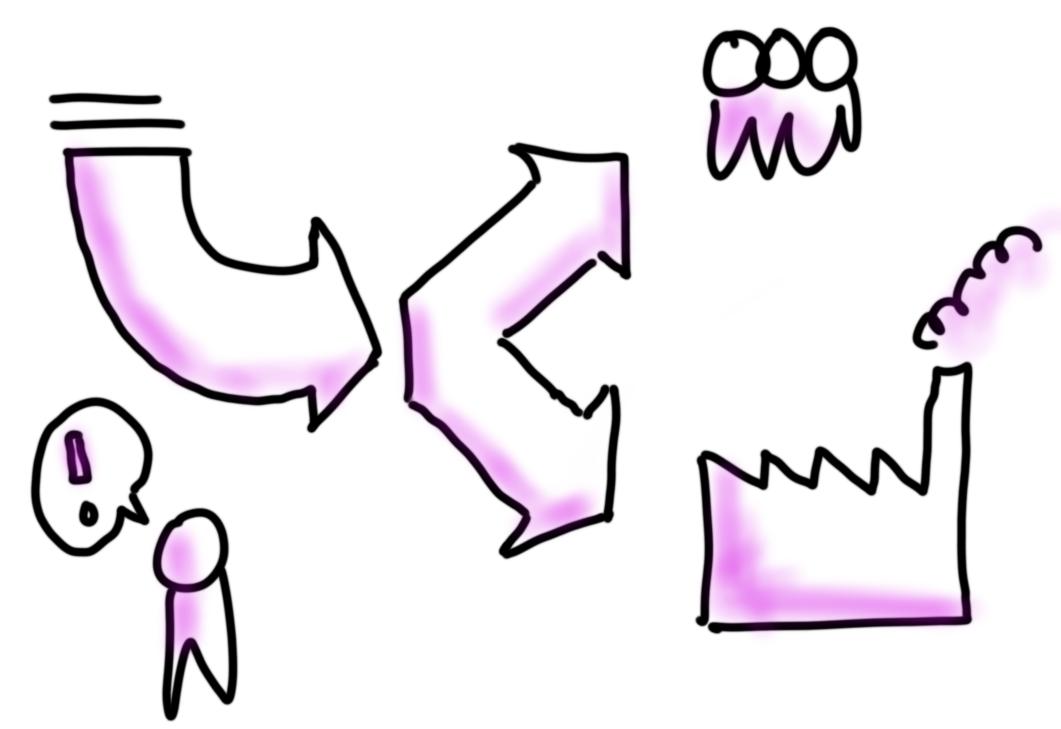The best process map ever?
We’ve all been there – trapped in the second or third meeting, mapping a process that we thought was simple… But instead of creating clarity and understanding, several of us are standing in front of a whiteboard-Visio-fishbone-PPT-swimlane-diagram-from-hell. And we’re “sooo close”… Sometimes I’ve seen this work simply freeze up and die. Other times one person takes over and abandons all other opinions in the interest of getting finished. Or perhaps the group works all night and hammers it out, maybe even gets it right for the moment.

But seldom, if ever, do I find that this work leads to the anticipated improvement. Usually people are frozen or abandoned, and those people that weren’t with us overnight just don’t get it. These process maps, while intended to unify, almost always lose their audience and thereby their effect.
We MUST simplify in order to have a chance. Five thoughts below to a simpler and better process map:
1 – Clarify the Input and Output
Input is the trigger that the process is dependent upon. Output is the result of the process (ultimately measured in improved value to customer). From/to whom? How many? What form? How fast? Be crystal clear on input and output and you’ll dramatically improve your process understanding.
2 – Max 5 steps*
Maybe it’s because we all count five fingers to a hand, but it seems that more than 5 steps just gets us lost. Be sure therefore to define maximum five steps that transform your process input to output. Get control over the end-to-end process on a high level before trying to detail and improve.
3 – Put the digital process map tools aside and draw by hand
Whiteboards and waving arms engage people WAY more than Visio. Everybody can draw five boxes, five arrows and five text phrases – start there. And why not document it thereafter by photographing it with your smartphone? The simple stuff goes a long way.
4 – Publish version 1 (before you overdo it)
If you’ve gotten this far, you have five steps on a whiteboard, photo-documentation and hopefully some arm movement as well. Call this version one and publish it. By publishing it, I mean make it available to stakeholders. Get in front of them and be able to illustrate and communicate your process succinctly in five steps. Expect feedback – it isn’t perfect. And then…
5 – Improve in small, frequent steps
Processes are not static, but like all things in business, always changing and adjusting. Instead of trying to get it perfect, be prepared to respond to feedback and publish frequent versions of your process. Demands and changes and details will arise – work them cyclically, publish your maps in new versions, and don’t get stuck.

Creating a simple process map is not the end, but instead a means of improvement. The mapping itself is not intended to create artwork, but instead improve our mutual ability to work efficiently and effectively. These thoughts are inspired by SIPOC, but you don’t have to know Lean** or Six Sigma to apply the ideas.
Get started, fail fast, learn faster and keep improving.
*NOTE – Max 5 steps is difficult. Significant value often involves expertise and detail. As we work and rework our process, the maps will inevitably increase in detail. This is good. I also suggest that all steps beyond five should be broken out as sub-steps, clearly linked to the five main steps. And I demand that we always know where we are as we work the process. We must be able to not only drill down, but also drill back up in order to engage others (don’t lose them!) and achieve value.
**NOTE 2 – of course, learning more about Lean is not a bad idea – check out our Lean IT Foundation cerfication or maybe engage your group in a Lean business simulation?
SIPOC guide
Read more about creating a simple process map in this blog about SIPOC. It even includes a link to our helpful SIPOC-template!

Kundcase Restaurangkedjan - bättre kontroll på leveranser
Onbird hjälper restaurangkedjan få bättre kontroll på och kortare ledtider i IT-leveranser
När är ledarskapet det största hindret till flöde?
I vår strävan efter högre effektivitet, snabbare leveranser och bättre flöde är det lätt att förbise en avgörande faktor: ledarskapet. Ibland är det just vi som leder som skapar de största hindren för flöde och värdeskapande.
Kartläggning av värdeflöden
Att förstå hur arbetet faktiskt flyter genom organisationen från idé till kund är avgörande för att lyckas med förbättringar. Här berättar vi hur en värdeflödeskartläggning kan hjälpa dig till effektivare flöden, engagerade team och ökad kundnöjdhet.

